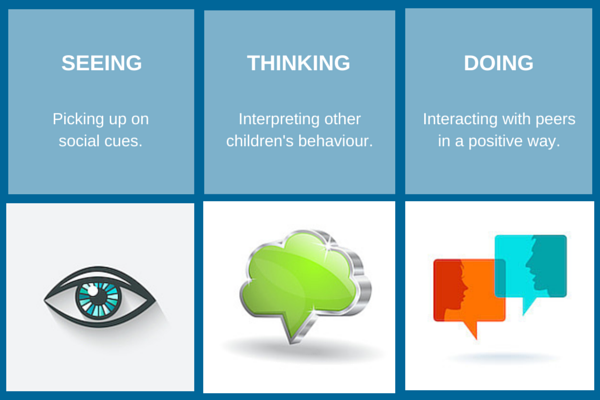
by Brie Barker | Leadership Development
My leadership blog is all about helping current and emerging leaders learn how to transform difficult conversations and dysfunctional workplace relationships into positive and productive ones.
3 Steps to Achieving Clarity in Workplace Conversations
When you were a kid, did you ever make your own telephone using two cans connected by a string? I sure did — and, much to my delight, that’s what I saw my two kids playing with this past weekend.
/
I got them to observe how the string needed to be taut and unobstructed in order for them to be heard by the person on the other end and, conversely, that when the string was loose and wobbly, they couldn’t hear the other person talking.
/
I talked about the science behind this and I think it actually got a bit of traction with them. A successful parenting moment that I made a mental checkmark of!
/
They were only able hear each other clearly when the line of communication was focused and direct.
/
/
With workplace conversations, don’t mistake the clear transmission of sound as achieving clarity of understanding — which should always be your goal.
/
And here’s the thing … achieving clarity of understanding is the primary responsibility of the person on the transmitting side, not the receiving side.
/
/
Why Clarity is Important:
/
Simple — you want the other person to fully understand you.
/
If you tell a staff member that the report they’re preparing needs to be clear, you don’t want them to interpret that as “Go and put a fresh toner cartridge in the printer.”
/
What Prevents Clarity:
/
Big picture? Your ego.
/
It’s easy to fall into the (usually-unconscious) trap of believing that everyone else interprets and filters the world around them exactly the same way you do. They don’t.
/
In all likelihood, the other person is going to receive your information and interpret it through their own filters.
/
Imagine this: I put one of my kids in the living room, the other one in the kitchen and I get them to close their eyes. I then hand each of them one end of their homemade telephone; however, they’re not close enough to each other for the string to be taut. I then ask them to have a conversation.
/
If you’re a parent, I bet you can see where this is going …
/
Not being to able hear each other, they soon get frustrated and both start shouting, “You’re not doing it right!!” Each of them has assumed the string was taut; believing it did not make it so.
/
What You Can Do to Achieve Clarity:
/
1. Take on 100% of the responsibility for it.
/
=> It’s up to you to ensure you are understood.
/
=> It’s up to you to ensure you understand the other person.
/
2. Say what you need to say.
/
How you frame and deliver what you need to say is extremely important in order for the other person to feel a particular way about what you’re saying; this is the kind of professional development I help leaders and managers with.
/
AND — you still have to say — with direct, clear language — what you need to say.
/
3. Check for understanding.
/
You need to further than saying things like, “Does that make sense?” or “Have I been clear?”
/
To really ensure that the other person gets it, you need to say something like this:
/
“I just want to be sure I communicated that fully, John. What’s your understanding of what I said?”
/
On the flip side, you can paraphrase back to the other person what they’ve said to ensure that you understand what they wanted you do:
/
“I just want to be sure I understand you fully, John. [paraphrase what they said] Is that accurate? Am I missing anything?”
/
Do these 3 things and your conversations will never slip into a game of “broken” telephone!
/
Have a productive and enjoyable day.
/
— Brie
3 Steps to Achieving Clarity in Workplace Conversations
When you were a kid, did you ever make your own telephone using two cans connected by a string? I sure did — and, much to my delight, that’s what I saw my two kids playing with this past weekend.
/
I got them to observe how the string needed to be taut and unobstructed in order for them to be heard by the person on the other end and, conversely, that when the string was loose and wobbly, they couldn’t hear the other person talking.
/
I talked about the science behind this and I think it actually got a bit of traction with them. A successful parenting moment that I made a mental checkmark of!
/
They were only able hear each other clearly when the line of communication was focused and direct.
/
/
With workplace conversations, don’t mistake the clear transmission of sound as achieving clarity of understanding — which should always be your goal.
/
And here’s the thing … achieving clarity of understanding is the primary responsibility of the person on the transmitting side, not the receiving side.
/
/
Why Clarity is Important:
/
Simple — you want the other person to fully understand you.
/
If you tell a staff member that the report they’re preparing needs to be clear, you don’t want them to interpret that as “Go and put a fresh toner cartridge in the printer.”
/
What Prevents Clarity:
/
Big picture? Your ego.
/
It’s easy to fall into the (usually-unconscious) trap of believing that everyone else interprets and filters the world around them exactly the same way you do. They don’t.
/
In all likelihood, the other person is going to receive your information and interpret it through their own filters.
/
Imagine this: I put one of my kids in the living room, the other one in the kitchen and I get them to close their eyes. I then hand each of them one end of their homemade telephone; however, they’re not close enough to each other for the string to be taut. I then ask them to have a conversation.
/
If you’re a parent, I bet you can see where this is going …
/
Not being to able hear each other, they soon get frustrated and both start shouting, “You’re not doing it right!!” Each of them has assumed the string was taut; believing it did not make it so.
/
What You Can Do to Achieve Clarity:
/
1. Take on 100% of the responsibility for it.
/
=> It’s up to you to ensure you are understood.
=> It’s up to you to ensure you understand the other person.
/
2. Say what you need to say.
/
How you frame and deliver what you need to say is extremely important in order for the other person to feel a particular way about what you’re saying; this is the kind of professional development I help leaders and managers with.
/
AND — you still have to say — with direct, clear language — what you need to say.
/
3. Check for understanding.
/
You need to further than saying things like, “Does that make sense?” or “Have I been clear?”
/
To really ensure that the other person gets it, you need to say something like this:
/
“I just want to be sure I communicated that fully, John. What’s your understanding of what I said?”
/
On the flip side, you can paraphrase back to the other person what they’ve said to ensure that you understand what they wanted you do:
/
“I just want to be sure I understand you fully, John. [paraphrase what they said] Is that accurate? Am I missing anything?”
/
Do these 3 things and your conversations will never slip into a game of “broken” telephone!
/
Have a productive and enjoyable day.
/
— Brie
© 2018 Connected Conversations™

by Brie Barker | Essential Post, Leadership Development
My leadership blog is all about helping current and emerging leaders learn how to transform difficult conversations and dysfunctional workplace relationships into positive and productive ones.
Essential Leadership Training: What to Consider and How to Choose
/
Simply making the decision — the commitment — to transform a dysfunctional workplace relationship is a crucial first step in making it happen. But that alone isn’t enough.
/
Are you fully prepared for your IRONMAN adventure race in workplace relationships?
/
This coming weekend, my wife, Jen, is participating in her first adventure race, Storm the Trent. She’s teaming up with her best friend, Jenn, and their team name is “The Two Jens”.
/
While that may not be the most creative team name, it certainly is accurate.
/
The race, billed as a beginner’s event, consists of 25 km of mountain biking, 6 km of trekking and 9 km of canoeing. In miles, that’s roughly 15½, 3¾ and 5½, respectively.
/
My take is that perhaps they call it a “beginner’s event” because they don’t expect anyone to actually finish; I have my doubts that I could. However, that is the one goal that my wife has in this race: to finish … or, perhaps, simply to survive.
/
There’s a specific collection of equipment and supplies that are mandatory for all race participants: some of which my wife already had, such as 6 Band-Aid brand bandaids (has no one ever required 7?); some of which she’s borrowing from Jenn, like a good bike; some of which she’s gone out to buy, such as a new bike helmet (who knew those things expired after 5 years?).
/
Here’s my 3-step summary of her preparation plan:
/
She committed.
She signed up, she paid the entry fee, she said “damn the torpedoes – full steam ahead!”
/
She did some homework.
She read about what was involved, gathered what equipment she would need and reviewed the map.
/
<iframe src="https://www.youtube.com/embed/k5hWWe-ts2s" width="420" height="315" frameborder="0" allowfullscreen="allowfullscreen" data-mce-fragment="1"></iframe>
/
What’s missing?
/
Training
/
The extent that Jen has trained for this event has indicated one thing for certain: her legs work. The reason for this is that she spends most of her waking hours attending to a demanding, full-time managerial job and at least equally demanding role as the mother to two, young children and the husband to yours truly. And she does an outstanding job on all fronts.
/
So the fact that Jen hasn’t done any focused training for her arduous journey ahead is completely understandable. After all, even if she comes back all battered and bruised, barely able to walk and swears that she’ll never do anything like that ever again, who cares? After all, the stakes aren’t high.
/
In my view, she’s already victorious.
/
But what if it wasn’t an adventure race she was embarking on?
/
What if her commitment was to transform a dysfunctional workplace relationship that she’s been suffering through?
/
That’s a different story.
/
/
Failing to achieve that goal
to transform that relationship has
very serious implications in 4 areas:
Chronic stress that poses major risks to your health and lowers your professional effectiveness.
Underperformance hinders your career advancement.
Strained group dynamics kill productivity.
Reduced effectiveness and profitability.
/
How to Train:
/
After you’ve made the commitment to transform a difficult workplace relationship, by all means, do some reading on the subject.
/
And then consider this …
/
Reading about how to do well in an adventure race and listening to someone tell you how to do well in an adventure race, is not the same as training for one.
/
Theory is important but it can only take you so far.
Training requires practice.
It’s getting your butt out on the bike, running the trails and paddling the canoe.
Then, come race day, your body and mind will be prepared — and you’ll be able to react effectively to whatever you encounter.
/
How to Choose the Right Leadership Training:
Decide what’s essential to your leadership development.
/
I firmly believe the most essential type of leadership training and development — for just about everyone — is learning how to create and maintain positive and productive workplace relationships, to be able to transform difficult conversations and dysfunctional workplace relationships into positive and productive ones.
/
If you’re not sure about this, explore my other blog posts and webpages and/or do some of your own research. In the end, you may decide this is what you need or you may not.
/
/
Choose a well-designed program and well-qualified facilitator.
/
Learning these essential leadership skills requires a program that effectively blends and leverages both theory and practice.
/
Choose a program that is designed and delivered by a leadership development specialist with unique experience and skills in this niche area.
/
If all of this leads you to me, that’s fantastic — I can’t wait to help you out!
/
If your search leads you to someone else, that’s fantastic, too! My only wish is for your growth and success as a leader.
/
Have a productive and enjoyable day.
/
— Brie
/
Essential Leadership Training: What to Consider and How to Choose
/
Simply making the decision — the commitment — to transform a dysfunctional workplace relationship is a crucial first step in making it happen.
But that alone isn’t enough.
/
Are you fully prepared for your IRONMAN adventure race in workplace relationships?
/
This coming weekend, my wife, Jen, is participating in her first adventure race, Storm the Trent. She’s teaming up with her best friend, Jenn, and their team name is “The Two Jens”.
/
While that may not be the most creative team name, it certainly is accurate.
/
The race, billed as a beginner’s event, consists of 25 km of mountain biking, 6 km of trekking and 9 km of canoeing. In miles, that’s roughly 15½, 3¾ and 5½, respectively.
/
My take is that perhaps they call it a “beginner’s event” because they don’t expect anyone to actually finish; I have my doubts that I could.
/
However, that is the one goal that my wife has in this race: to finish … or, perhaps, simply to survive.
/
There’s a specific collection of equipment and supplies that are mandatory for all race participants: some of which my wife already had, such as 6 Band-Aid brand bandaids (has no one ever required 7?); some of which she’s borrowing from Jenn, like a good bike; some of which she’s gone out to buy, such as a new bike helmet (who knew those things expired after 5 years?).
/
Here’s my 3-step summary of her preparation plan:
/
1. She committed.
She signed up, she paid the entry fee, she said “damn the torpedoes – full steam ahead!”
2. She did some homework.
She read about what was involved, gathered what equipment she would need and reviewed the map.
3. Well …
<iframe src="https://www.youtube.com/embed/k5hWWe-ts2s" width="420" height="315" frameborder="0" allowfullscreen="allowfullscreen" data-mce-fragment="1"></iframe>
/
What’s missing?
/
Training
/
The extent that Jen has trained for this event has indicated one thing for certain: her legs work.
/
The reason for this is that she spends most of her waking hours attending to a demanding, full-time managerial job and at least equally demanding role as the mother to two, young children and the husband to yours truly.
/
And she does an outstanding job on all fronts.
/
So the fact that Jen hasn’t done any focused training for her arduous journey ahead is completely understandable.
/
After all, even if she comes back all battered and bruised, barely able to walk and swears that she’ll never do anything like that ever again, who cares? The stakes aren’t high.
/
In my view, she’s already victorious.
/
But what if it wasn’t an adventure race she was embarking on?
/
What if her commitment was to transform a dysfunctional workplace relationship that she’s been suffering through?
/
That’s a different story.
/
/
Failing to achieve that goal to transform that relationship has very serious implications in 4 areas:
Chronic stress that poses major risks to your health and lowers your professional effectiveness.
Underperformance hinders your career advancement.
Strained group dynamics kill productivity.
Reduced effectiveness and profitability.
/
How to Train:
/
After you’ve made the commitment to transform a difficult workplace relationship, by all means, do some reading on the subject.
/
And then consider this …
/
Reading about how to do well in an adventure race and listening to someone tell you how to do well in an adventure race, is not the same as training for one.
/
Theory is important but it can only take you so far.
Training
requires
practice.
It’s getting your butt out on the bike …
and paddling the canoe.
Then, come race day, your body and mind will be prepared — and you’ll be able to react effectively to whatever you encounter.
/
How to Choose the Right Leadership Training:
Decide what’s essential to your leadership development.
/
I firmly believe the most essential type of leadership training and development — for just about everyone — is learning how to create and maintain positive and productive workplace relationships, to be able to transform difficult conversations and dysfunctional workplace relationships into positive and productive ones.
/
If you’re not sure about this, explore my other blog posts and webpages and/or do some of your own research. In the end, you may decide this is what you need or you may not.
Choose a well-designed program and well-qualified facilitator.
/
Learning these essential leadership skills requires a program that effectively blends and leverages both theory and practice.
/
Choose a program that is designed and delivered by a leadership development specialist with unique experience and skills in this niche area.
/
If all of this leads you to me, that’s fantastic — I can’t wait to help you out!
/
If your search leads you to someone else, that’s fantastic, too! My only wish is for your growth and success as a leader.
/
Have a productive and enjoyable day.
— Brie
/
© 2018 Connected Conversations™

by Brie Barker | Leadership Development
Mention the term “toxic employee” and almost every manager will shudder as their mind conjures up an image of a specific employee, past or present. Consider this as you read: it’s effectively managing these “troublesome” employees that justifies your paycheque; it’s easy to manage the positive and productive ones.
I began last week’s post with the words, “People are not born leaders — but every leader was born.” While researching this week’s post I came across a post of J. Maureen Henderson’s  on Forbes, titled We’ve Created a Monster: Toxic Employees Aren’t Born, They’re Made. Thanks for the segue, Maureen!
on Forbes, titled We’ve Created a Monster: Toxic Employees Aren’t Born, They’re Made. Thanks for the segue, Maureen!
 Henderson focuses her exploration on “what happens when that bad apple is also your golden goose” and holds up a mirror for us to see the roles our broader and organizational cultures play in creating these people and keeping the dirt unswept and hidden under the rug. (Would anyone like to buy a letter Q?)
Henderson focuses her exploration on “what happens when that bad apple is also your golden goose” and holds up a mirror for us to see the roles our broader and organizational cultures play in creating these people and keeping the dirt unswept and hidden under the rug. (Would anyone like to buy a letter Q?)
What I’d like to focus on is the employees whom many managers would think of as the typical, everyday, garden variety toxic employee. So, I’m not talking about those situations that include illegal activity such as theft and sexual harassment, i.e. things that absolutely demand a formal process and strict applications of human resource policies.
I’m talking about those employees that managers see as just being a real pain in the

… employees they recognize in flavours like those described by Reuben Yonatan  :
:
⇒ The Hot Mess
⇒ The Slacker
⇒ The Martyr
⇒ The Socialite
⇒ The Sociopath
4 Steps to Detoxifying Toxic Employees:
No matter which toxic flavour you’re dealing with, there are 4 steps you can follow to turn things around:
#1 – Change Your Mindset
#2 – Prepare for “The Conversation”
#3 – Have the “The Conversation”
#4 – Follow Up
Today’s post is going to expand on Step #1.
#1 – Change Your Mindset
A. Extract head from sand.
 Let go of the idea that somehow this problem will go away by itself. Dan Rockwell
Let go of the idea that somehow this problem will go away by itself. Dan Rockwell  echoes my belief here, in stating, “Leaders and organizations become toxic when they don’t deal with tough issues.” Commit to stepping up and commit to making the situation better.
echoes my belief here, in stating, “Leaders and organizations become toxic when they don’t deal with tough issues.” Commit to stepping up and commit to making the situation better.
B. Remove the label “toxic” from your employee.
 This is a fixed belief that leaves no room or hope for change. This isn’t about forgetting the person’s destructive behaviour, it’s about removing a road block to changing that behaviour.
This is a fixed belief that leaves no room or hope for change. This isn’t about forgetting the person’s destructive behaviour, it’s about removing a road block to changing that behaviour.
C. Engage your compassion.
 It’s extremely doubtful that you have an employee who wakes up each day with the express intention of wreaking havoc at work. Most commonly, toxic behaviour is a symptom of emotional pain. I’m not talking about being all “touchy-feely” just for the sake of it — this is pragmatic: problems that are rooted in emotional distress require empathy and compassion to address them effectively. You have to decide to care about getting this person to a better frame of mind.
It’s extremely doubtful that you have an employee who wakes up each day with the express intention of wreaking havoc at work. Most commonly, toxic behaviour is a symptom of emotional pain. I’m not talking about being all “touchy-feely” just for the sake of it — this is pragmatic: problems that are rooted in emotional distress require empathy and compassion to address them effectively. You have to decide to care about getting this person to a better frame of mind.
Changing your mindset like this is necessary before going into Step #2 – Preparing for “The Conversation”. More on that later!
Have a productive and enjoyable day.
— Brie
Share your thoughts and leave a comment:
- What other shifts in mindset have you found helpful in effectively managing a toxic employee?
- How important is this?
Part 2 of the series of posts on Leadership Education is still on the horizon!

by Brie Barker | Leadership Development
People are not born leaders — but every leader was born. The best leaders have another thing in common, regardless of what sector, industry or professional field they work in, and that’s the ability to communicate effectively with people. Early childhood is the ideal place to begin an education in this essential leadership skill.
My kids are still quite young: Finley is 8 and Clara is 5. They certainly have their own distinct personalities already and I’m so curious to see how they will evolve; who they will become as adults.
And, like most parents, I feel the weight of responsibility, shared with my wife, in not making a complete mess of it all and end up sending them out into the world without everything they need to survive and thrive.
To them, however, their glorious futures are all set:

 Finley’s going to play professional baseball with the Red Sox and Clara’s going to have some yet-undefined career that revolves exclusively around Frozen (“Oh, sorry, sweetie, I think we left that CD at Grandma’s”).
Finley’s going to play professional baseball with the Red Sox and Clara’s going to have some yet-undefined career that revolves exclusively around Frozen (“Oh, sorry, sweetie, I think we left that CD at Grandma’s”).
Will these things come to pass? Maybe yes, maybe no. But that’s okay, there’s plenty of time for them to explore more things before they need to focus on getting any concentrated, career-specific education and training.
Like us, if parents of young kids want to maximize the chances of their kids being successful in the working world, no matter what kind of career the kids end up choosing, they will need to be able to communicate effectively with people — and learning those social skills has to happen now.
Because, according to most experts in child psychology and development, the window for learning these social skills starts to close pretty tightly around the age of 8.
Ways to Help Children Develop Their Social Skills:
Thankfully, there are a lot of well-informed experts in child psychology and development out there because that’s not my area of expertise … I know for a fact that even my becoming a parent had nothing to do with what’s on my resumé.
In their article, Social Skills: Laying the Foundation for Success, Sharon Lynch and Cynthia Simpson give a great definition of social skills:

“Social skills are behaviors that promote positive interaction with others and the environment. Some of these skills include showing empathy, participation in group activities, generosity, helpfulness, communicating with others, negotiating, and problem solving.”
Hmmm … sounds like hallmarks of a good leader to me.
The article goes on to provide great strategies that can be used at home, in school and in the community for helping kids develop their social skills, some of which could be applied in the adult workplace, too.
Psychology Today hosts a blog called Growing Friendships, written by Dr. Eileen Kennedy-Moore, which has a ton of helpful and interesting information about children’s social and emotional development.
In a 2011 post of hers, What Are Social Skills? Helping Children Become Comfortable and Competent in Social Situations, she explains three main processes that underly social skills for children — and adults alike:

It’s easy to see how these three things translate to the working world of adults. Dr. Kennedy-Moore goes on to say that, “Some kids seem to learn social skills very easily, but others can benefit from some extra coaching.” Same goes for current and aspiring leaders, my friends!
The parents of young children who strike while the iron’s hot and focus on developing their kids’ social skills in those crucial, early years, do their kids a big service.
Will doing so guarantee their kid a leadership role in the working world? No, but their kids will benefit from being able to embody a key part of leadership in whatever role they inhabit.
Am I doing a good job of this with my kids? I hope so. Let’s see what they’re like in another 15 years or so! With any luck, it won’t end up like this.
Part 2 of this series of posts on Leadership Education will focus on undergraduate options for those kids about to leave the nest. My hair will be even more grey when that happens for me … if that’s actually possible.
Leave a comment!
Not sure what to say? Answer one of these questions:
What strategies of yours have worked well in building your kids’ social skills?
What correlation do you see between your own childhood and how you embody your role as a leader?
What’s your favourite song from Frozen? (Besides the one you never have to hear again.)
Have a productive and enjoyable day.
— Brie

by Brie Barker | Leadership Development
As a leader, it serves you to consider where your own persona might be what’s preventing you from hearing the potentially valuable ideas of particular employees. Don’t miss the gems that aren’t expressed with the fanfare of a brass band.
Friends of my wife have a 2,000 acre farm up in New Lisgard, Ontario, about an 8-hour drive from either Toronto or Ottawa, where they raise beef cattle. Last summer, Jen and I decided it was about time we went for a visit, so we packed our rubber boots and told the kids they were going to see where hamburger really comes from.
Being a born-and-bred city boy, I learned a lot of things about life on a farm while I was there. For example, 2,000 acres covers a LOT of land and cows are really quite BIG — and how well Brad keeps track of the whereabouts, health and pregnancy status of all 300+ of them is nothing short of astounding. If Brad’s not there when a cow is giving birth, there’s a very real chance that the calf won’t survive. From a business perspective, the economic benefit that calf represented would be completely lost. The cow could die from the inattention, too.

If the farm you run is indoors, measured in square footage and has a human population versus bovine, then it’s the good ideas your herd is capable of producing that you can’t afford to miss. Beyond having to create an environment where new ideas can gestate (a great topic on its own), you have to be sure you can hear the moo of every employee who is trying to contribute.
As a leader, it serves you to consider where your own persona might be what’s preventing you from hearing the potentially valuable ideas of particular employees.
For example, last week I was working with a client — we’ll call him Jeff — who felt unheard by his boss. Jeff is keenly aware that he’s very shy and soft-spoken; he also holds the belief that decisions should be guided by facts. By great contrast, Jeff describes his boss as one who is always outgoing, loud, extremely confident and makes decisions based on his gut-feelings, without input from others.
When Jeff tries to give what he believes to be valuable input to his boss, his boss’s now-predictable response quickly leaves Jeff feeling overwhelmed, unheard and unvalued: he ends up retreating and shutting down.
Although I was working with Jeff to help him learn what he can do on his part to increase the likelihood of being fully heard by his boss, let’s consider the coaching tips for Jeff’s boss that could increase his capacity to hear Jeff fully.
Shift Your Mindset:
1.  Become a servant leader.
Become a servant leader.
“When we seek to discover the best in others, we somehow bring out
the best in ourselves.” — William Arthur Ward

2. The level of confidence and certainty with which one presents
an idea is not necessarily indicative of the merits of the idea.
Set the Stage:
Express to Jeff your desire to hear and consider his ideas and, acknowledging your tendency to dominate a discussion, give him permission to tell you if he’s starting to feel shut down.
Adapt your Communication Style:
Jeff needs to feel invited and safe to fully express himself:
⇒ Reduce the intensity of your vocal and physical expression to more closely mirror Jeff’s.
⇒ Leave enough silence so Jeff doesn’t feel rushed.
⇒ Encourage Jeff to say more by using verbal nods and showing curiosity with statements like, “Hmmm, tell me more.”
⇒ Ensure Jeff’s said his piece: “Is there anything else in this that you think is important for me to consider?”
⇒ Thank Jeff for sharing his thoughts and that you’ll give them further consideration.
⇒ Follow up with Jeff as to whether or not you implemented his suggestions and why. This doesn’t detract from your authority or send the message that you have to justify your decisions to Jeff, rather, it just demonstrates that you value his ideas. Even if one idea doesn’t prove to have merit, it doesn’t mean the next one won’t — and you want to be sure he feels invited to share it with you.
This is but one example showing what a leader can do to move past their own persona’s restrictions in order to receive the potentially valuable ideas a particular employee has to offer.
How’s your persona getting in the way and with whom?
As a leader, what can you change in your own behaviours to remove your barriers?
Lacking opposable thumbs, how likely is it that even a really smart cow could send a text message?
Have a productive and enjoyable day.
— Brie

by Brie Barker | Leadership Development
Trust is the lifeblood of effective, enduring leadership.
Want your employees to trust you enough to follow you just about anywhere?
Here are 4 things you can do to earn trust as a leader.
Read the following list while embracing two important concepts:
» Trust is based on the emotional connections between people, not on the connections between people on an org chart.
» Heed the good advice of Aristotle that any good novelist, playwright or screenwriter does: character is action.
1. Show Your Face:
You know the show Undercover Boss? Strive to never be a viable candidate for that show. You want to be the boss that every one of your employees will take one look at in that disguise of yours and say, “Hey, nice try! I know who you are!”
But it needs to go beyond that.

©DonkeyHotey
Don’t be that holy visitor from the top floor who walks briskly through the cube farm and bellows Pythonesque pomposities like, “Morning, Johnson! Keep up the good work now!”
You need to know who they are. You need to demonstrate you care about them by taking an interest in who they are and what their day-to-day working reality is all about: what the value they bring to the organization is, what their challenges and suggestions are.
If you’re leading such a big group of people that the goal of knowing all of them is just not feasible, you should still schedule a regular time in your calendar to make the rounds and have some meaningful face time with as many as you can. This is not an all or nothing scenario.
Trust is based on relationship. The person who is trusted never has to say, “Trust me,” and will never hear the reply, “Trust you? I don’t even know you.”
2. Put Your Employees’ Interests Above Your Own:
If you poll your employees about whether or not they trust you, many of them will filter this question as, “Do I trust them to do what’s best for me?” Or, in other words, do they think you’ve got their back; that, when the chips are down and things get tough, do they trust that you’ll put their interests before your own personal interests.

For a deeper exploration of this, delve into Simon Sinek‘s latest book, Leaders Eat Last.
For a more concise affirmation, trust Spock’s statement, “The needs of the many outweigh the needs of the few – or the one.”
3. Lead by Example:
Think about any movie you’ve ever seen that involves an armed battle. Now think about the leaders of each opposing side. Which side almost always emerges victorious? The side whose soldiers have the most trust in their leader — the side who’s leader joins them in the actual battle, not the one who commands from the safety of the rear.

If you’re calling on your employees to sacrifice for the good of the organization, you need to sacrifice, too. You need to be right there in the trenches with them, sleeves rolled up, showing them you believe in the cause you’re asking them to fight for.
4. Trust the People You’re Leading
Another key factor in earning the trust of your employees is demonstrating that you trust them.
I’m not talking about throwing people into the deep end, just assuming they can swim to the other side, and then saying, “Hey, I gave you a chance to prove yourself and you blew it. From now on you don’t leave the shallow end unless I’m there to watch you.” The only people who should be micro-managed are those who respond well to being micro-managed.
Rather, give your employee a goal to accomplish, ask them to devise and show you their plan to achieve it, offer any necessary guidance, and then get out of the way and empower them with 100% trust to accomplish it. Based on the results, adjust the amount of active support you need to give them. You’ll soon discover what their full abilities are: if they meet or surpass the expected standard, great, you know you can trust them to get the job done; if they don’t meet the expected standard, you can collaborate on a learning and development plan to address the areas of needed improvement. Do this and they’ll trust you have their best interests at heart.
 “The best way to find out if you can
“The best way to find out if you can
trust somebody — is to trust them.”
— Ernest Hemingway
Have a productive and enjoyable day.

![]()


![]()


![]()












![]()
![]()

![]() on Forbes, titled We’ve Created a Monster: Toxic Employees Aren’t Born, They’re Made. Thanks for the segue, Maureen!
on Forbes, titled We’ve Created a Monster: Toxic Employees Aren’t Born, They’re Made. Thanks for the segue, Maureen! Henderson focuses her exploration on “what happens when that bad apple is also your golden goose” and holds up a mirror for us to see the roles our broader and organizational cultures play in creating these people and keeping the dirt unswept and hidden under the rug. (Would anyone like to buy a letter Q?)
Henderson focuses her exploration on “what happens when that bad apple is also your golden goose” and holds up a mirror for us to see the roles our broader and organizational cultures play in creating these people and keeping the dirt unswept and hidden under the rug. (Would anyone like to buy a letter Q?)
![]() :
: Let go of the idea that somehow this problem will go away by itself. Dan Rockwell
Let go of the idea that somehow this problem will go away by itself. Dan Rockwell ![]() echoes my belief here, in stating, “Leaders and organizations become toxic when they don’t deal with tough issues.” Commit to stepping up and commit to making the situation better.
echoes my belief here, in stating, “Leaders and organizations become toxic when they don’t deal with tough issues.” Commit to stepping up and commit to making the situation better. This is a fixed belief that leaves no room or hope for change. This isn’t about forgetting the person’s destructive behaviour, it’s about removing a road block to changing that behaviour.
This is a fixed belief that leaves no room or hope for change. This isn’t about forgetting the person’s destructive behaviour, it’s about removing a road block to changing that behaviour. It’s extremely doubtful that you have an employee who wakes up each day with the express intention of wreaking havoc at work. Most commonly, toxic behaviour is a symptom of emotional pain. I’m not talking about being all “touchy-feely” just for the sake of it — this is pragmatic: problems that are rooted in emotional distress require empathy and compassion to address them effectively. You have to decide to care about getting this person to a better frame of mind.
It’s extremely doubtful that you have an employee who wakes up each day with the express intention of wreaking havoc at work. Most commonly, toxic behaviour is a symptom of emotional pain. I’m not talking about being all “touchy-feely” just for the sake of it — this is pragmatic: problems that are rooted in emotional distress require empathy and compassion to address them effectively. You have to decide to care about getting this person to a better frame of mind.

 Finley’s going to play professional baseball with the Red Sox and Clara’s going to have some yet-undefined career that revolves exclusively around Frozen (“Oh, sorry, sweetie, I think we left that CD at Grandma’s”).
Finley’s going to play professional baseball with the Red Sox and Clara’s going to have some yet-undefined career that revolves exclusively around Frozen (“Oh, sorry, sweetie, I think we left that CD at Grandma’s”).


 Become a servant leader.
Become a servant leader.
“The best way to find out if you can